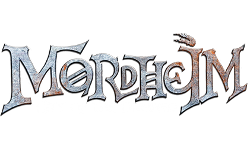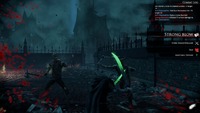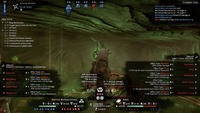|
|

|
PLATFORM
|
PC
|
BATTLE SYSTEM
|

|
INTERACTION
|

|
ORIGINALITY
|

|
STORY
|

|
MUSIC & SOUND
|

|
VISUALS
|

|
CHALLENGE
|
Hard
|
COMPLETION TIME
|
60-80 Hours
|
|
OVERALL

|
+ Complex, strategic battles
+ Difficult, yet somewhat forgiving
- Gets repetitive at higher levels
- No story to speak of
- Too many random die rolls
|
Click here for scoring definitions
|
|
|
Mordheim: City of the Damned is the latest of Game Workshop's efforts to bring their venerable Warhammer franchise to video games, and wears its origins proudly. Based directly on the Mordheim tabletop wargame, City of the Damned is a turn-based tactical RPG focusing on squad-based combat weighed down by a perhaps overwhelming amount of stats, skills, and die rolls. It also features a campaign reminiscent of the XCOM franchise, and much like those games tries to emphasize the permanent consequences of failure: the game auto-saves after every action, and an entire campaign can be lost. That said, it expects players to fail regularly and allows them to make a comeback.
Players are placed in command of a warband belonging to one of several factions, each with their own separate campaign, and each making a life in the titular city of Mordheim. Formerly the imperial capital, the city was devastated by a demonic meteorite and is now populated primarily by cultists, demon-hunters, looters, and those with plans for the empty imperial throne. The most basic goal of the campaign is to acquire Wyrdstones: mysterious, powerful magical rocks left behind by the meteorite. A certain number of Wyrdstones are demanded by the warband's sponsor, and repeatedly failing to meet their quota will end the campaign. The rest will be sold off for the cash needed to keep the band's soldiers trained, equipped, and healthy. If the player is careless with their spending, it's possible to fall into a death spiral where they lack the money to pay their soldiers, and lack the soldiers to earn money.
The vast majority of missions are skirmishes on one of many randomly chosen battlefields, pitting the player up against another evenly-matched warband racing to pick up the Wyrdstones scattered across the map. This adds an interesting layer of strategy, as defeating the enemy isn't the only goal, and indeed winning too quickly will abandon valuable stones. These maps also give the player one of three randomly chosen optional objectives to complete, such as capturing an idol from the enemy's starting point, which will both give their team bonus experience and further complicate the decision-making. The symmetrical nature of these battles makes them perfectly suited for the game's multiplayer mode. To make up for a rather stupid AI, enemies are given passive stat boosts to ensure that even when they climb to high places they can't get down from, they're still a threat.
 Armless men gang up on innocent murder-rats.
Armless men gang up on innocent murder-rats.
|
|
In addition to these missions, the game will periodically have special story missions to assault enemy strongholds. These are unique maps with complicated layouts, story-related hero units, and each with half a dozen objectives to complete. Sadly, these are also few and far between, and are given only the barest narrative framework: "There are bad guys there. Go kill them and take their stuff!" In fact, there's only one real story character in each faction's campaign: the warband's immediate commander who mostly serves as a narrator for mission text. While the writing does take care to give that one character a unique voice, they end up fairly flat regardless. The story maps are also reused between the different campaigns, although the objectives are different enough that the battles will play out differently.
The base game has four different factions to choose from, and there are two more available as DLC. In classic Warhammer tradition, there is a grim quality to each involved, and even the Order factions range from pragmatic mercenaries to zealous inquisitors. The Chaos factions include demonic cultists and cutthroat rat people. The main difference between the factions are what units are available, which determines both initial and maximum stats, available spells, and what kinds of weapons they can use. That said, the vast majority of skills are shared between all factions, and the basic strategies the player will use are not going to be significantly different. At least with over a hundred skills to choose from within the first hour of gameplay, some variety can be gleaned.
Combat makes up the bulk of the gameplay, and while it is engaging it also has a steep learning curve. Given the huge number of stats and buffs to keep track of, some players will feel overwhelmed even after the tutorial. On each unit's turn they are granted two kinds of action points to spend, depending on their class and level. Strategic points are used for both movement and defensive skills, while offense points are used to either attack or cast spells. Some advanced skills will use a combination of both points, and juggling how to efficiently use up both points each turn can be an interesting puzzle. Movement is handled by freely moving the character, in the style of Valkyria Chronicles, within a relatively small circle that indicates that character's movement range. Reaching the edge of the circle will use up another strategic point and create a new circle centered on their current location.
Once a unit touches an enemy's zone of control, they are considered "engaged" with that enemy and they can no longer move unless they either spend valuable action points to disengage or all the enemies they are engaged with are defeated. In that sense, combat is mostly about trying to maintain advantageous positioning by surrounding weak enemies and not exposing vulnerable flanks. When a unit is defeated in combat, they don't necessarily die, but they can have their equipment stolen by the enemy and at the end of battle will receive a random permanent injury. These range from near death experiences that provide bonus experience to missing limbs, brain damage, and yes, permanent death. Characters can be literally crippled, in that someone who is missing limbs may no longer be equip shields, or climb walls, or whatever else, and it may be best to retire them. It's not all bad though: their character model will be updated with a cool peg leg or glass eye, and higher level enemies will randomly spawn with the same sorts of injuries, keeping things fair.
 That's a lot of numbers, to be perfectly honest.
That's a lot of numbers, to be perfectly honest.
|
|
And these injuries will definitely happen at some point in every campaign, because the game is incredibly random at every level. Hit rates tend to hover around eighty percent, and on top of that most units will have another fifty percent chance to dodge or parry the first hit made against them. Nearly every action, including jumping over small gaps and casting spells, requires a skill check. Even with stats and equipment min-maxed to increase the odds, there is always a minimum five percent chance of failure for any action, which is practically guaranteed to eventually happen at a key moment. Players who expect everything to go precisely as planned will be extremely frustrated by this, although those who play the odds to minimize risk will be rewarded.
Back at base camp, players can buy items, customize their soldiers, or simply pass the time. While only one mission can be completed per day, passing time is also necessary to heal up or train new skills, which both temporarily remove the unit from the active party. Too much downtime will result in missed deadlines though, so reserve slots are provided to swap units in and out of the active team as necessary. On the other hand, it can be difficult to keep the reserves at useful levels and with decent equipment. Party slots are divided broadly into heroes and henchmen, and can only fit the corresponding type of unit, so players are forced to bring a mixture of stronger and weaker units. Heroes get about twice as many action points as henchmen, so these skewed power levels will definitely need to be taken into account when dividing forces in battle.
The game's UI is abysmal. There are half a dozen different contextual commands available at any given moment, and they're all activated by the same button. Players can either scroll through them all one by one, or open up a circular menu divided into many subtabs, which honestly isn't much better. Enemies will routinely use unfamiliar skills and spells, and their effects can't be checked unless they leave a buff or debuff. The game is equally awkward to control with either a mouse and keyboard or a controller, although in different ways. Menus in particular are a pain to navigate with a controller. That said, players will get used to it over time, and as a turn-based game it rarely interferes with gameplay.
Both graphically and musically, the game is competent but unlikely to wow anyone. The artists nailed the aesthetics of a ruined city corrupted by eldritch evil, but since that's the only setting it gets tiresome. A lot of care was put into the details of each unit, including the same weapons looking different in the hands of a different faction, but the models have a low polygon count and are inflexible, resulting in wooden-hair syndrome. The same applies to the music, which is appropriately atmospheric and grim, but also unmemorable and players likely won't regret putting on their own soundtrack. The only voicework is narration of the mission text along with some grunts in battle.
Overall, Mordheim: City of the Damned is compelling for strategy fanatics who enjoy a challenge, but doesn't offer much else to other players. Even with the setting of Warhammer behind it, limiting things to a single city with a handful of factions can make things feel small and repetitive. The gameplay is fairly deep, but the steep learning curve will potentially turn off a lot of players.
Review Archives
|









